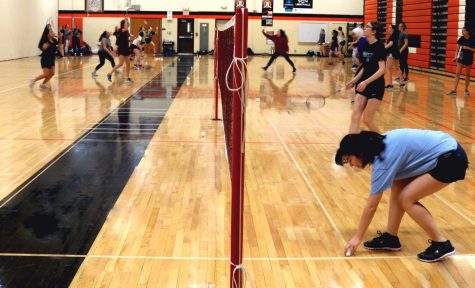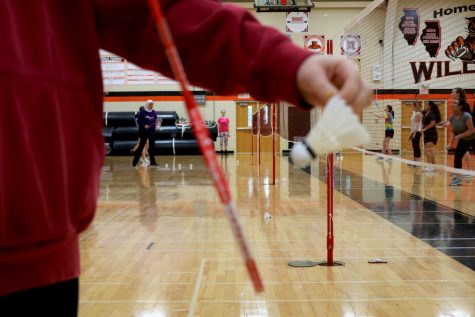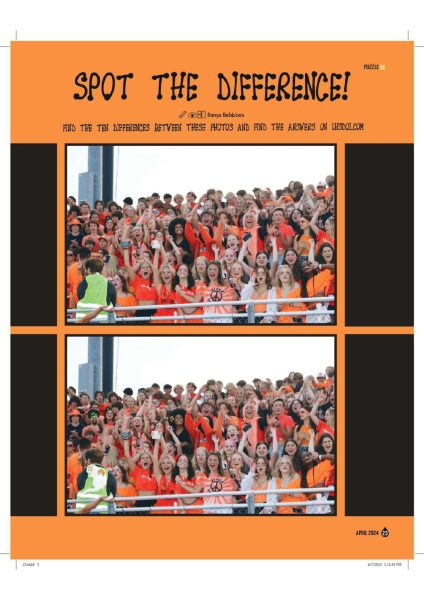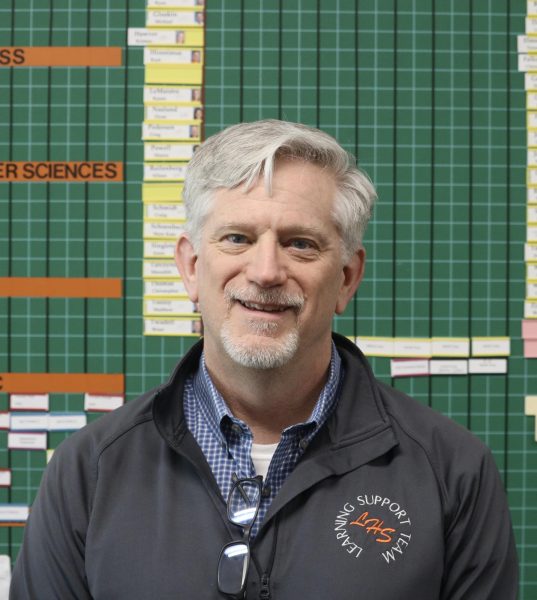Competitive Nature
Restraints Cause 38% to be Dropped at Tryouts
For the two years that the girls badminton program has existed at Libertyville High School, at least 50 girls have tried out for the team; however, the team’s maximum amount of players allowed is 36, due to space, coaching and time constraints.
This season, 59 girls tried out, an increase by nine compared to last year. Of those, 23 girls — 38 percent of the athletes who tried out this year — did not make the team.
“It’s just weird to have it super competitive because usually I wouldn’t think of our sport as being [really competitive],” junior team captain Annalisa Waddick, a two-year player, said.
The increased competition at this year’s tryouts may have stemmed from the positive environment that was created around last year’s team, which Waddick described in an interview.
There are also physical benefits to being a member of the team that could have appealed to some athletes: “Badminton’s a great sport. It gets you in all-around shape. It strengthens your legs, your arms, your core — basically everywhere,” said freshman and varsity athlete Kathleen Jin.
Last season, there were 50 girls on the first day of tryouts for the brand-new team. However, 14 girls did not return the following days of tryouts, leaving the team at its maximum of 36 players. Mrs. Judi Neuberger, the team’s head coach, said that the girls who did not return did so because they didn’t fully realize the commitment that came along with the team.
With a similar tryout turnout, the LHS girls basketball program normally has about 50 girls try out every year. According to Head Girls Basketball Coach Mr. Greg Pedersen, they cut 1-2 girls per year, amounting in a 2-4 percent cut for their whole program.
While that is a substantial difference of cuts when compared to badminton, it is important to note the different restraints that each sport experiences. These limitations include available coaching staff and facilities. For example, there is only one gym that has the ability to set up badminton nets, and there are two coaches for the three teams.

The LHS badminton team — made up of exhibition, JV and varsity levels — competes in doubles and singles matches, but all practice together in the Main Gym.
Furthermore, when comparing other sports to badminton, another element that causes a contrast in the percentage of athletes cut would be that some athletes decide not to try out. These individuals are not accounted for in the official amount of athletes cut, indicated Mr. Greg Loika, head girls volleyball coach.
This can be seen in the following statistics: 13 percent of girls who tried out for volleyball in the previous season were cut. When Mr. Loika included the 10 girls who were in the program the previous season but didn’t try out this season, that number rises to 28 percent, showing a closer comparison between badminton and volleyball.
Coach Neuberger stated that they have a maximum amount of players for their three teams: varsity, junior varsity and exhibition. The exhibition team plays at meets but does not keep score like the varsity and junior varsity levels do.
As the main gym is the sole location where badminton courts are able to be set up, with eight courts of four girls each, amounting to 32 players at a given time, they have a strict cap on the amount of players they can keep on the team.
“If we had more space, if we had more coaches, I would take everybody. I want everybody to love badminton!” said Coach Neuberger.
With 23 girls to cut this year, Coach Neuberger and Assistant Coach Ms. Laura Govorchin had to make some tough decisions.
Before this spring season, the Libertyville athletic directors met with and advised all of the coaches of this spring sports. In anticipation of certain sports having to make cuts from their team, Mr. Randy Oberembt expressed that he and co-interim Athletic Director, Mr. John Fischl, consulted with the respective coaches. While making those decisions, the athletic directors often advise coaches to quantitatively measure their decisions and remove the emotional component to give every player an equal and fair opportunity. Coach Neuberger felt that measuring tryouts this way was the best option “because the badminton team from last year was [her] family.”
Coaches Neuberger and Govorich took data from the tryouts on a one-to-five number scale. The scale measured execution of skills, such as certain shots or serves. The other component that was considered in their final decisions was attitude, reaction to feedback and attempts to improve after receiving feedback.
Among the 36 athletes who made the team were Jin and Waddick. In separate interviews, they expanded on the process and described it as complicated and stressful.
Waddick communicated that there was a lot of sadness on that final day of tryouts because seemingly everyone wanted to make the team: “It was [hard] because we all care so deeply about it so evidently [that] when things don’t work out, you’re gonna be disappointed.”
On the third day of tryouts this year, the coaches took an hour to verbally deliver cuts. Due to the fact that there were some individuals who were on the team last year but did not make it this year, the coaches wanted to personally explain their selections.
Junior Paula Magnuszewski tried out and made the badminton team last year, however, she did not make the team this year.
“It was really intimidating because we didn’t have tryouts last year,” she said.

In badminton, the rules for serving required players to hit the shuttle below the waist and serve behind the line. The shuttle has to be hit back over the net in order for the point to count.
With sadness also came confusion for a few athletes, specifically the ones who did not make the team.
“I was definitely flabbergasted. I was really shocked,” Magnuszewski added. While being cut was not a good experience, Magnuszewski elaborated that the athletes were treated with respect in the process and stated that Coach Neuberger was “gentle and easy going into it. It was a hard thing to talk about.”
Tryouts weren’t the only occasion that the athletes could showcase their skill; beginning in early December, there were seven open gyms that took place about every other week, according to Coach Neuberger. The open gyms were available to any player.
Coach Neuberger expressed that the open gyms enabled the players a chance to get to know the game and rules before tryouts. This allowed the team to focus on skills and footwork, rather than the fundamentals at the beginning of their season.
“I feel that we are getting better faster than we did last year because I’ve got that base already,” Coach Neuberger said.
After girls were told they did not make the team, they were encouraged to try out again next year. There was not a guarantee they would make it again, just like any other sport. They were, however, given feedback and suggestions on areas of their play to improve upon. Magnuszewski is planning on trying out again next season to avoid missing an opportunity, she said.
On the court, both the JV and varsity teams started off beating their opponents in their first match. Varsity then beat Zion-Benton and Wheeling on March 13 in a triangular meet, in what was described by Coach Neuberger as a “good, solid win.”
The Wildcats continued this streak by beating Warren. On March 17, the team came in fourth at the Hersey Invitational, with doubles partners Angie Baquiran and Jin earning first-place medals. As of April 9, the team is 3-2, after losses against Lake Forest and Stevenson.











